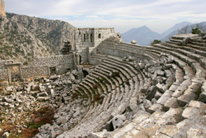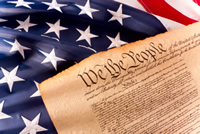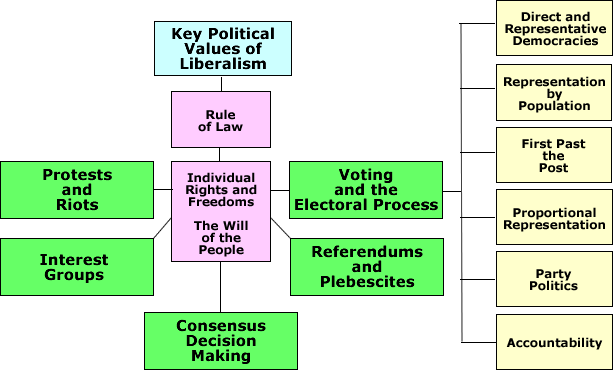Lesson 2: The Will of the People
2. Lesson5.2.1 The Will of the People
Democratic Liberalism and the Political Spectrum
Begin your examination of democratic liberalism by looking at the entire political spectrum. Because you will be learning more about democracy, you should now have a closer look at the political spectrum. This spectrum shows how political systems can differ in the amount of power held by the government and by the people.
How does the democratic political system fit into the political spectrum? Examine the following political spectrum carefully.

The political spectrum is a continuum that allows comparison of governments in various countries. The amount of government control a government exercises on its people determines where a country is on the political spectrum. Liberal democracies occupy the central part (blue section) of the spectrum ranging from democratic socialism to conservatism.
| Political systems moving toward the left-hand side of the spectrum typically favour more government control. | Political systems moving toward the right-hand side of the spectrum typically favour less government control. |
|---|
However, in dictatorships on the extreme left and the extreme right of the political spectrum, government control is large: communism and fascism.

Ancient Greece
Liberal Democracy
Ancient Greece is credited with beginning democracy. The people of Athens, Greece, used the term demokratia to describe their form of government-demos means "the people" and kratia means "authority". Democracy is a form of liberal government in which representatives are elected by the citizens of a society to make decisions on their behalf.
Democracy is a system of government that allows people to choose their leaders in the hopes that those leaders will reflect their interests. These elected representatives give a voice to the people who elected them.-
People choose who will govern.
-
People can replace an unfavourable government.
-
People have the opportunity to voice their opinions about government.
When these conditions exist, a government represents the will of the people; that is, the government does what the citizens of a country want to happen. Liberal governments exist only when the will of the people is heard. That will can be heard best when the people choose who will govern at election time.
Democratic Limits on Government Power
What is important to people in separate societies differs according to time and the type of political system that exists. This helps explain why various political systems have arisen. What is important today may not be tomorrow, and what is important to one group may not be important to another.
At one time, political rights were the focus of attention, as seen in the American Revolution (1776), French Revolution (1789), and even the Russian Revolution (1917). People were seeking political rights:
-
the right to be involved in political decision-making
-
the right to be a part of making laws
-
the guarantee of individual rights and freedoms in a constitution
Recognizing the Will of the People
At the beginning of the American Revolution in 1776, representatives from the Thirteen Colonies wrote the American Declaration of Independence. It began with, "We the People..." reflecting the will of the people in the Thirteen Colonies to form their own country, the United States of America. The Declaration of Independence went on to state that all men were created equal and that they were given certain inalienable rights (cannot be taken away), such as life, liberty, and the pursuit of happiness.
Later, in 1789 in France, the Declaration of the Rights of Man and the Citizen pointed out the need to limit government powers by protecting liberty and property, by preventing arrest for no legitimate reason, and by limiting excessive taxation.

The American Constitution
Democracies constructed constitutions to guarantee certain rights and protect people from oppressive government. In effect, this means that government in a democracy becomes an agent for the people. As a result, government is by the people.
This means that people have the ultimate power because they choose, remove, or keep politicians in political office. This makes elected politicians answerable to the people who have elected them. If the majority of people do not like what has occurred, they can, at the next election, vote for someone else.
Of course, a majority of the people have to vote for change for this to occur. That is why the act of voting is so important for all eligible persons. Competition for power keeps politics free and open, and it helps to keep a democratic government from becoming a dictatorship.
The Practices of Democracy that Reflect Values of Liberalism
The key values of individualism and liberalism are emphasized in the following diagram along with the practices that reflect individual rights and freedoms:

Proportional Representation
In the First-Past-the-Post section, some would argue that an election where the candidate with the most votes wins does not represent truly the will of the people. Some liberal democracies such as Sweden, Germany, Brazil, and others have chosen proportional representation as their electoral process.
In proportional representation, generally citizens do not vote for a person to represent them, but rather, they vote for a political party. Usually, citizens can choose from several political parties. Each citizen votes for the party he or she feels represents their beliefs and values best. The number of votes a party obtains will determine the number of people that party can put in government. That number of people is a percentage of the total number votes cast in the election.
For example, if in an election there are four political parties to choose from and 100 voters, the results could be as follows:
Party 1 got 45 votes or 45% of the total votes
Party 2 got 25 votes or 25% of the total votes
Party 3 got 15 votes or 15% of the total votes
Party 4 got 15 votes or 15% of the total votes
Each of the parties puts some of its people into the government. However, because Party 1 got a larger percentage of the votes, Party 1 gets to have more people in government than any of the other parties. This is balanced out somewhat because Parties 2, 3, and 4 together have more people in government than Party 1 does. So, Party 1 will not always get its way.
A good point about proportional representation: People from various political parties are in the government, which represents a better cross section of the will of the people. Always deals must be worked out between the parties because no one party can dominate the government - unless one party received well over 50% of the votes.
A bad point about proportional representation: This system can be quite complicated. Decisions may take quite some time until deals are worked out among parties. If a deal cannot be determined, then the government becomes ineffective.
Please watch this brief video which explains the difference between a first-past-the-post electoral system and proportional representation


Refer to pages 284-286
After concluding the lesson and watching the video: What do you think?
Is proportional representation more indicative of the will of the people than the first-past-the-post system?
Still need a bit more of an explanation?
Go to your textbook, Understandings of Ideologies, and read Proportional Representation on page 284-286. These pages will further your understanding of the concept of liberal democracy.
You should make notes, either on paper or on your computer, about what you have read.